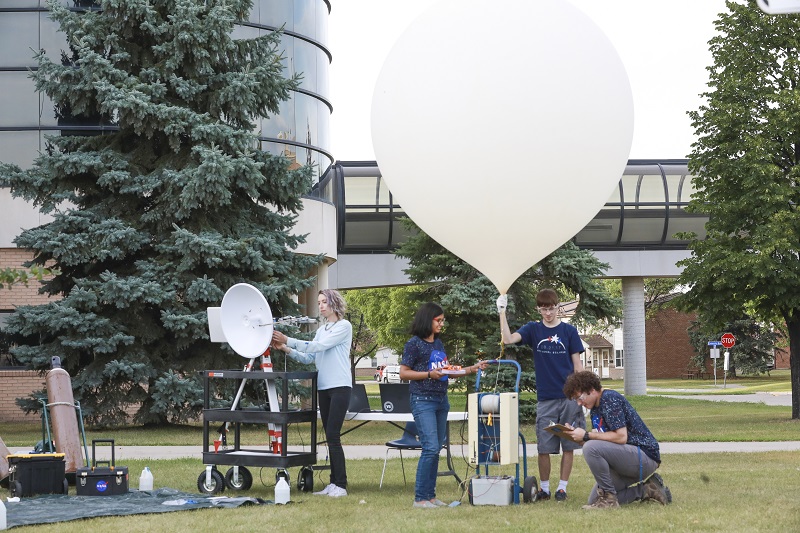Total eclipse of the sun
UND’s high-altitude balloons set to capture live video of Aug. 21 solar eclipse

Imagine watching the Great American Eclipse of 2017 live, anywhere on Earth.
UND students – and students across the nation – have been working around the clock to make that happen.
“The Aug. 21 event is a total solar eclipse,” said Marissa Saad, coordinator of the North Dakota Space Grant Consortium on campus. “This is awesome – it usually doesn’t happen in the U.S. It’s very rare for tens of millions of people to be in the eclipse path.”
And for the first time, those who aren’t in the eclipse path, which curves roughly from Oregon to South Carolina, can still watch it live.
Fifty-five student teams, including one from UND Space Studies, will conduct high-altitude balloon flights from various locations along the eclipse path and send live video and images from near space to NASA’s website.
“Together, we’re bringing an awesome experience to the world,” said Saad.
The graduate students, part of the Eclipse Ballooning Project spearheaded by Montana State University and funded by NASA, will travel to Rexburg, Idaho, which is on the path of the eclipse.
They will launch a high-altitude balloon 100,000 feet into the atmosphere – practically into space. The balloons, which expand to the size of a school bus, will carry a still camera, video camera, and equipment to record the event.
“We’re so excited,” said Saad. “This is a once-in-a-lifetime opportunity – people will never forget it. This eclipse is a human experience.” That experience could influence the next generation and inspire them to become astronomers, scientists or engineers, she added.
“I’m excited that the eclipse is finally almost here, and it will be great to see the results we get,” said Denise Buckner, a space studies master’s student who is leading the UND team. “This is the first time anyone has coordinated a balloon launch this large.”
Along with the cameras and tracking equipment, the team will launch 88 ping pong balls decorated by third graders in New Town, N.D., and then return the “eclipsed” balls to students.
The project is funded by NASA’s Science Mission Directorate and the National Space Grant College and Fellowship Program, and students have designed all the components, from software to equipment.

Solving a master puzzle
There are a lot of challenges, logistics and coordination to ensure that the balloons launch at the correct time, the cameras operate properly, and the live streams work, and the students have been working around the clock.
“It’s like putting together a lot of pieces in a master puzzle,” said Saad. “We have to launch the balloon at exactly the right time and at the right altitude. There is a lot of math involved.”
And a bit of a dilemma: Will the students watch the eclipse live, or will they watch it from their control station?
They’re hoping to do both.
“We’ll be outside with the satellite dish and computers,” said Buckner. “We’ll be watching it online to make sure everything is working, and keep an eye on the sky.”
And even if it’s cloudy, viewers will still get a show, said Saad. That’s one of the reasons there are so many teams across the eclipse path: to ensure great coverage.
“If 100 percent of the sunlight is blocked by the moon, we’ll still realize the light disappeared – clouds or no clouds,” said Saad. “I’m quite excited!”
If it’s too cloudy, the balloons can’t launch because pilots wouldn’t be able to see them.
“If the clouds come in after the balloon ascends, I’d expect the Moon’s shadow on the clouds would be amazing to view,” said Saad.
Rock the glasses
Wherever you are, wear protective glasses, said Saad, who noted that staring at the sun can damage vision and even cause blindness. Special viewing glasses have sold out but are available online. Even welding visors will work.
Grand Forks will see a partial eclipse around 11:38 a.m., totality (with the moon covering 80 percent of the sun) at 12:58, and it will be over by 2:18 p.m., Saad said. Even though Grand Forks won’t see a total eclipse, it will turn noticeably darker.
The eclipse itself will last about two minutes, and the entire event will last about three hours, Saad said.
“This is not something to miss,” said Buckner. Whether you watch it live from the ground or your device, it’s the experience of a lifetime.


